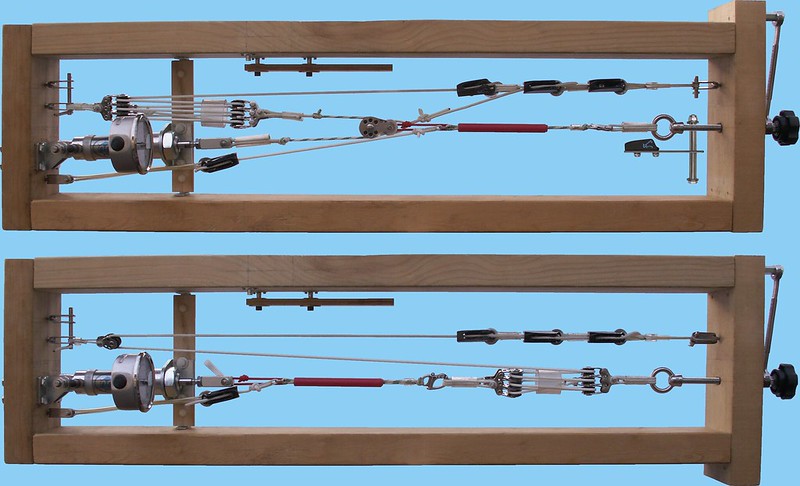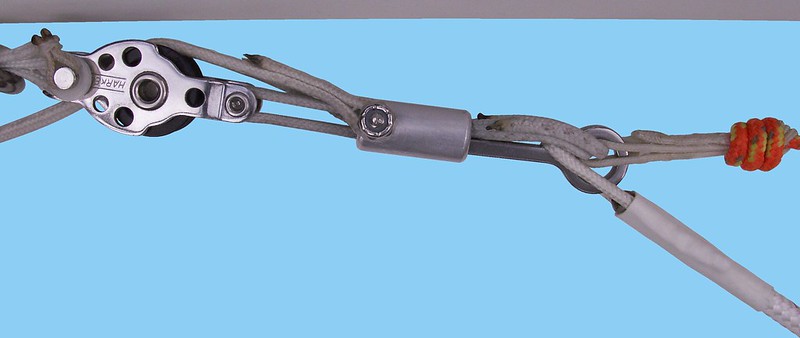Then why am I measuring an actuation force of only 11 when the load is 85?
If you look at your no load test video (like I did again after reading this)...
That spring is nowhere NEAR bottomed out when the release fires. And it's gonna be a lot less bottomed out when the load is 85 pounds.
15*11.
No.
- Fifteen is ALWAYS a denominator (unless you're measuring your pull and trying to figure how much load you just dumped).
- The spring NEVER gets multiplied by anything - just added to or subtracted from. And if eleven is the bottomed out force - just subtracted from.
My thinking was...
If eleven is the slack line figure I would predict that as you start loading up the release and elongating the Spectra the required pull will drop for a bit before it starts going back up.
If that's the case, a(85) should be at least 14.7...again, I measured 11.
Working backwards...
- You measured the slack line pull at eleven - that's all spring compression and the spring compression will only go down and stabilize as you load things up.
- You also measured eleven at 85 pounds.
- The load to actuation ratio is fifteen so 5.7 pounds is friction and 5.3 is spring.
- And the spring should be accounting for only 5.3 (or less) from that point on.
...and it's not going to be constant...
Yeah, you're throwing a constant spring compression factor into the equation and the more you load things up the smaller the fraction of the pull the spring's gonna represent.
This is the only data point I have...
That's the only data point you NEED. That's just 25 pounds towline under your tug's weak link - and 227 pounds towline OVER your current weak link - and the pull is about a fifth of what you're gonna be doing when the adrenaline kicks in.
(I wish I could get you to do fewer equations and more drilling. (Drill, baby, drill!))
I wish I had a way to get some for higher loads...
That load tester...
http://www.flickr.com/photos/aerotowrelease/8317889807/

...is one of the coolest and funnest toys I ever built.
...it takes about 5kg just to compress the spring. This is added to the force needed to retract the barrel.
Two mistakes...
- You want the spring force ONLY enough to reliably hold the barrel forward when you're in prep and dolly loading modes. Anything more and you're working against yourself.
- Just 'cause the pin shaft is about thirty millimeters long doesn't mean you need the barrel to cover the whole length. Only the absolute tip of the shaft is doing anything and you just want the barrel far enough forward to reliably secure the tip when the release is max loaded.
http://www.flickr.com/photos/aerotowrelease/8306258400/

My barrel just engages half the shaft. Joe's covers the whole damn thing. That's more wasted hand motion and the more motion you have the more of a pain in the ass the spring becomes.
- why don't you put the pulley harnessed onto the downtube inside it...
You can't.
The release harnessed to the keel moves (and you want it to).
- It pulls forward a little when the system is loaded up.
- It rotates on the keel whenever you turn or get turned away from the tug.
- You may want to adjust the trim by changing the fore/aft position.
You couldn't keep the lanyard lined up with the release unless the exit hole were huge.
You want the lanyard - inside the conduit - to exit the downtube at shallow angle (minimal bend) to the pulley and let the pulley redirect the pull as needed.
...or 3 of them in a three to one mechanical advantage ?
You don't need a three to one. You don't even need two to one. You're adding weight to the glider for the entire flight to do a job that's over in a fraction of a second.
..."WW could do that as a VG system"..
The VG system is a little easier to do. You're coming straight out of the top of the downtube to a pulley hard mounted on the keel and shooting pretty much straight forward to a rather fixed target.
I'm surprised that the rubber band inside the controlbar...
That's a doubled quarter inch bungee. You can set the power to pretty much anything you want.
I think I set mine so it would hit the lanyard with about dozen pounds. That means the release would get hit with twice that. That would blow nearly four hundred pounds of direct load. The weak link at the top end of my bridle is 272.
(If I set the bungee tension real high the pin gets a bit hard to pull - but as it is I think it's something in the ballpark of four pounds.)
- and what about the friction of the leechline inside the plastic tubing (downtube entry and exit) ?
The nylon tubing is very slick and I'm keeping the bends very shallow. And on Zack's glider there would only be one bend at the top exit. At the bottom it would be routed through a VG pulley - just like a VG cord.
- this plastic tubing won't finally slide in or outside the hole of the downtube ?
It could. It doesn't. It's a tight fit, it's only subjected to an extremely short light lanyard pull when the when the barrel is moving back at actuation. Even if it pulled into the downtube all the way the release would still blow. (And I use a little more protrusion than what's depicted in the photos.) I check it during setup but it's pretty much a nonissue.
that's a big deal !!!
No bigger a deal than for any other release configuration at the same trim setting. It just means that for any given trim setting the point at which the top end of the bridle is fixed has to be farther aft than it would if there were no tensioner going to the nose and you don't have a lot of room to waste between the control frame apex and the front end of the release mechanism.
---
Edit - 2012/04/06 22:08:00 UTC
The first chunk of the second sentence in the above paragraph is wrong.
- The effective trim point is the intersection of the line defined by the upper length of the bridle with the keel.
- Tensioning to the nose moves the release and bridle end forward and up.
- Moving the bridle end forward and/or up results in a faster trim.
- If you tension to the nose you have to position the release farther aft to maintain the same trim.


